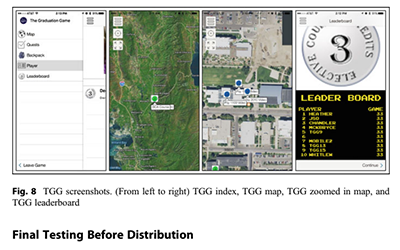Students turn ITLS Class Projects into Published Book Chapters

Place caption here
Students from the Fall 2017 “Mobile Technologies” course turned their class projects into book chapters for the Handbook of Mobile Teaching and Learning published this year. Tressa Haderlie (ITLS MA Alumna), Apoorva Chauhan (CS PhD Candidate), and Whitney Lewis (ITLS MS Alumna) turned an augmented reality game project into a chapter called “The Graduation Game: Leveraging Mobile Technologies to Reimagine Academic Advising in Higher Education.” Apoorva Chauhan and Whitney Lewis also published a chapter on augmented reality used for learning called, “Location and Place: Two Design Dimensions of Augmented Reality in Mobile Technologies.”
“I didn’t anticipate that the project would be published,” explained Haderlie. “I started this project as partial fulfillment of my course requirements for ITLS 6870: Mobile Technologies. Being an academic advisor, I wanted to create something that would serve my students in a new, efficient, and fun way.”
Haderlie is an undergraduate advisor in the Psychology Department. As the book chapter explains, Haderlie headed up the creation of an augmented reality game that “was designed to (1) acquaint students with the institution (USU) and the psychology department’s program requirements and (2) form connection between students and their academic advisor” (Haderlie, Chauhan, Lewis, & Litts, 2019, p. 4). More than 80 students played the game during the prototype testing to walk through a mini game-like experience of their graduation requirements. Most students (71%) reported they would continue using the game in subsequent years.
Chauhan explained, “Tressa’s idea of The Graduation Game and the low-fidelity prototypes she developed to playtest her game made me believe in the game’s potential to be useful for students to know and remember the requirements of their academic program.”
The book chapter about The Graduation Game outlines in detail the iterative design process they used to create the game and the affordances of augmented reality for this type of learning.
In addition to a book chapter on this real-world class project, Dr. Breanne Litts, the course instructor, reported another published book chapter from students in the course. “Apoorva Chauhan and Whitney Lewis also published a more theoretical piece to build our understanding of mobile technologies for learning,” Dr. Litts said.
Chauhan remembers getting an email after the completion of the course for “an opportunity to write book chapters on the materials we covered.” Chauhan and Lewis’ theoretical piece puts forward a theoretical framework to aid in the learning design of augmented reality experiences.
“We present an argument that ‘location’ (user’s physical location) and ‘place’ (user’s engagement with his/her physical location) are the two key design dimensions for Augmented Reality (AR) based educational technologies,” Chauhan said.
The y-axis of a quadrant they designed relates to place engagement, or the “sociological, ideological, political, and ecological dimensions” of a location. The x-axis relates to the physical location the game is being played in and whether it’s necessary for gameplay. The authors then identified where various existing augmented reality games would fit within their quadrant.
“I hope after reading this chapter, designers will be more inclined to use ‘location’ and ‘place’ in their design of mobile technologies for learning, which in turn, would allow situated learning,” Chauhan explained.
The Handbook of Mobile Teaching and Learning, the book these chapters are published in, provides “provides in-depth background information and cases studies in high technology teaching and learning” regarding mobile technologies. The book includes chapters about using cell phones and tablets in the classroom, apps used for teaching and learning, virtual reality, augmented reality, and more. You can get the book or learn more about it on Springer’s website.
Dr. Litts emphasizes, “Our students can build on what they do in our classes and turn this work into publications and/or real world projects for use in practice.”

